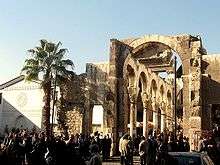Temple of Jupiter, Damascus

The Temple of Jupiter in Damascus was built by the Romans, beginning during the rule of Augustus[1] and completed during the rule of Constantius II.[2]
An ancient Aramaean temple to Hadad once stood on this site. The Romans associated Hadad with Jupiter, and rebuilt the temple in Jupiter's name.[2] The temple drew large crowds to its festivals and Damascus became famous as the city of Jupiter.[1]
Theodosius I converted the temple to a church dedicated to John the Baptist. After the Muslims took over Damascus in 635 CE, the church was shared for seventy years, but Al-Walid I converted it to the Umayyad Mosque.[2]
Construction
The inner court, or temenos is believed to have been completed soon after the end of Augustus' reign in 14CE. This was surrounded by an outer court, or peribolos which included a market, and was built in stages as funds permitted, and completed in the middle of the first century CE. At this time the eastern gateway or propylaeum was built. The end of the second, century during the reign of Septimius Severus, saw a major upgrading in a more flamboyant style.[1]
Archaeology and interpretation
Richard Pococke published a plan of the temple compound in 1745 in his work A Description of the East and Some other Countries, Vol. II. In 1855 the Reverend Josias Porter published a plan showing 40 surviving columns or column fragments which still survived between houses in the area. In 1921 Wulzinger and Watzinger made a plan showing the peribolos to measure some 350m by 450m.[1]
References
- 1 2 3 4 Burns, Ross (2005). Damascus: a history. Routledge. pp. 61–. ISBN 978-0-415-27105-9.
- 1 2 3 Finegan, Jack (1981). The archeology of the New Testament:the Mediterranean world of the early Christian Apostles. Taylor & Francis. pp. 58–60.
Coordinates: 33°30′42″N 36°18′14″E / 33.511552°N 36.3038°E